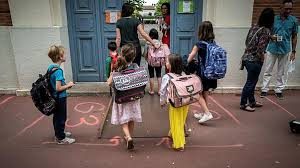Overseas Situation Report Wednesday 7th July 2021
By Mike Evans
“Children are the living messages we send to a time we will not see.” – John F. Kennedy
In this report we look at the impact the pandemic has had on the lives and education of the young across the world. We focus on the report by the WHO and what they feel needs to be done to bring children back into the classroom.
 In a recent report published by the WHO, they recommended that schools should remain open for as long as possible with adequate public health and social measures in place, and governments should use the summer months to implement measures that protect in-person schooling in the next school year, This report was from an international group of experts established by the World Health Organization’s Regional Office for Europe, in its latest recommendations on schooling during Covid-19.
In a recent report published by the WHO, they recommended that schools should remain open for as long as possible with adequate public health and social measures in place, and governments should use the summer months to implement measures that protect in-person schooling in the next school year, This report was from an international group of experts established by the World Health Organization’s Regional Office for Europe, in its latest recommendations on schooling during Covid-19.
The updated recommendations come against the backdrop of rising infection rates in some countries in the Region, primarily due to the combination of the relaxation of public health and social measures, increased social mixing and vaccine inequity across the Europe.
 “The summer months offer a valuable window of opportunity for governments to put in place the right set of measures that will help keep infection rates down and avoid resorting to school closures, which, as we have seen, have such a harmful effect on the education, social and mental well-being of our children and youth,” said Dr Hans Henri P. Kluge, WHO Regional Director for Europe. “The spread of new variants, coupled with the presence of pockets of unvaccinated people in school settings, means that there is no time to lose. The time to act is now. We can’t allow the pandemic to rob children of their education and development.”
“The summer months offer a valuable window of opportunity for governments to put in place the right set of measures that will help keep infection rates down and avoid resorting to school closures, which, as we have seen, have such a harmful effect on the education, social and mental well-being of our children and youth,” said Dr Hans Henri P. Kluge, WHO Regional Director for Europe. “The spread of new variants, coupled with the presence of pockets of unvaccinated people in school settings, means that there is no time to lose. The time to act is now. We can’t allow the pandemic to rob children of their education and development.”
“Despite most countries offering remote learning, the learning loss and impact of not being in school have been challenging for children. This is particularly so for vulnerable and marginalized children. Over the past year, parents and caregivers have tried to adapt to their ‘new’ learning environment, but we can’t risk having another year of disruptions,” said Afshan Khan, UNICEF Regional Director for Europe and Central Asia. “We need to work together throughout the summer to ensure that children can go back to school safely and catch up with their learning.”
“We must get out of the Covid-19 caused crisis in education and health with more resilient education and health care systems, and pursue ambitious goals to recover education and transform it so that every student learns better, has stronger social and emotional skills, better health and well-being,” said Tao Zhan, Director of the UNESCO Institute for Information Technologies in Education (UNESCO-IITE). “We have to act now. The future of this generation is at stake.”
The updated recommendations focus on eight key points affecting children and schooling during the Covid-19 pandemic:
- The use of PCR or rapid diagnostic antigen tests in school settings;
- The need for studies that assess the effectiveness of risk-mitigation measures on infection control;
- The importance of safeguarding educational outcomes, mental and social well-being;
- The need to account for children living in vulnerable situations;
- Changes in the school environment that benefit child health and infection control;
- The importance of including children in all decision-making;
- Vaccination strategies in school settings; and
- Keeping schools open as the key overarching objective.
School closures should be considered only as a measure of last resort, if and when “large outbreaks occur or transmission in the community cannot be controlled by any other measures,” the TAG members note in their recommendations.
 Across the WHO European Region, the pandemic had a dire impact on schooling during the 2020-2021 academic year. UNESCO’s monitoring of national distance learning solutions shows that 44 out of 53 countries in the WHO European Region closed their schools at the national level at the height of the pandemic in April 2020.
Across the WHO European Region, the pandemic had a dire impact on schooling during the 2020-2021 academic year. UNESCO’s monitoring of national distance learning solutions shows that 44 out of 53 countries in the WHO European Region closed their schools at the national level at the height of the pandemic in April 2020.
School closures have serious effects on the education, development and well-being of children and adolescents. In addition to depriving them of the necessary social interactions that support and promote their mental well-being, school closures led to remote learning arrangements that did not offer the same educational outcomes. In addition, even in the best settings, socially disadvantaged children and those in greater need of educational support have fallen behind, increasing social inequity between and within countries.
While most countries reopened their schools at the end of summer 2020, rising infection rates in the autumn and winter months led to more stringent measures across dozens of countries, including, in some areas, the closure of schools. However, research carried out in some Member States during the winter months of 2020 shows that SARC-CoV-2 incidence among students was lower than in the general population, with secondary infections in schools accounting for less than 1% of infections.
According to the report, in the 2020 to 2021 academic year, we saw the largest disruption to education in history. With these recommendations, we now have the evidence and tools to ensure that children and young people can return to in-person schooling safely.
Covid-19 is reported less frequently in children than in adults. Transmission in education settings can be limited if effective mitigation and prevention measures are in place. In school settings across the WHO European Region, more outbreaks are reported in secondary and high schools than in primary schools (settings with children up to 10–12 years of age).
Outbreaks in schools that involve only staff members are also observed. Data suggests that children and adolescents are followers, not drivers, of the pandemic, with a slower dynamic in younger children. There is, to date, no evidence that in-school transmission is a significant driver of increasing infection levels. However, the emergence of new variants of Covid-19, which have been shown to have increased transmissibility, require an ongoing risk assessment-based approach with appropriate in-school mitigation measures a pre-requisite to keeping schools open.
While precautions must be taken to control the spread of Covid-19 in the community, including through school-based measures, a balance must be struck between imposing such measures and ensuring that children are able to continue learning and socializing to the greatest extent possible.
All infection control measures have the potential to have adverse effects on educational outcomes, mental health, social well-being and health-related behaviours. It therefore is necessary to consider carefully the positive and negative effects of implementing them. Evidence suggests that learning loss and falls in school enrolment rates due to lockdown, school closures and even distance learning is several times higher in schools in the most deprived areas compared to those in less deprived areas.
 Schools deliver essential functions beyond education that cannot be delivered online, including the opportunity for real-life interactions with peers, which is essential for healthy development. Online teaching therefore remains a suboptimal alternative. In addition, there is evidence that more children are experiencing food insecurity due to lack of school meals, and levels of violence against children increase when staying home during lockdowns and school closures.
Schools deliver essential functions beyond education that cannot be delivered online, including the opportunity for real-life interactions with peers, which is essential for healthy development. Online teaching therefore remains a suboptimal alternative. In addition, there is evidence that more children are experiencing food insecurity due to lack of school meals, and levels of violence against children increase when staying home during lockdowns and school closures.
In general, data shows that the factors influencing the impact of Covid-19 on learning proficiency are: adapting teaching to the new context; protecting child nutrition; and maximizing contact time.
The report finishes with a list of recommendations which include the following:
When closing schools, countries need to guarantee uninterrupted substitute and adapted services for those normally delivered in the school setting, such as special needs education, health services and school meals, where possible;
Countries should secure sufficient support for teaching to be adapted to the new situation and context to minimize learning losses;
Countries should guarantee affordable access to devices and facilities required for online learning and teaching, including functioning Internet connections for schoolchildren and teachers, regardless of whether schools are closed or open, and making sure students and teachers have sufficient digital skills; and Countries should establish hotlines for children and adolescents seeking psychological support.
The pandemic is a temporary thing while the education of the young is something that affects everyone in the future. Without the educated to fill the roles of industry and commerce in the future everyone and every country will suffer.
Until the next time, Stay Safe.
Total Cases Worldwide – 185,393,558
Total Deaths Worldwide – 4,009,289
Total Recovered Worldwide – 169,736,766
Total Active Cases Worldwide – 11,647,503 (6.3% of the total cases)
Total Closed Cases Worldwide – 173,746,055
Information and resources:
